Managing Food & Beverage Operations
VerifiedAdded on 2023/01/04
|11
|3772
|373
AI Summary
This assignment focuses on different types of businesses in the food and beverage industry, rating systems used, current and future trends, and the impact of technology on operations and marketing. It also explores factors influencing consumer decisions and strategies to attract loyal customers.
Contribute Materials
Your contribution can guide someone’s learning journey. Share your
documents today.
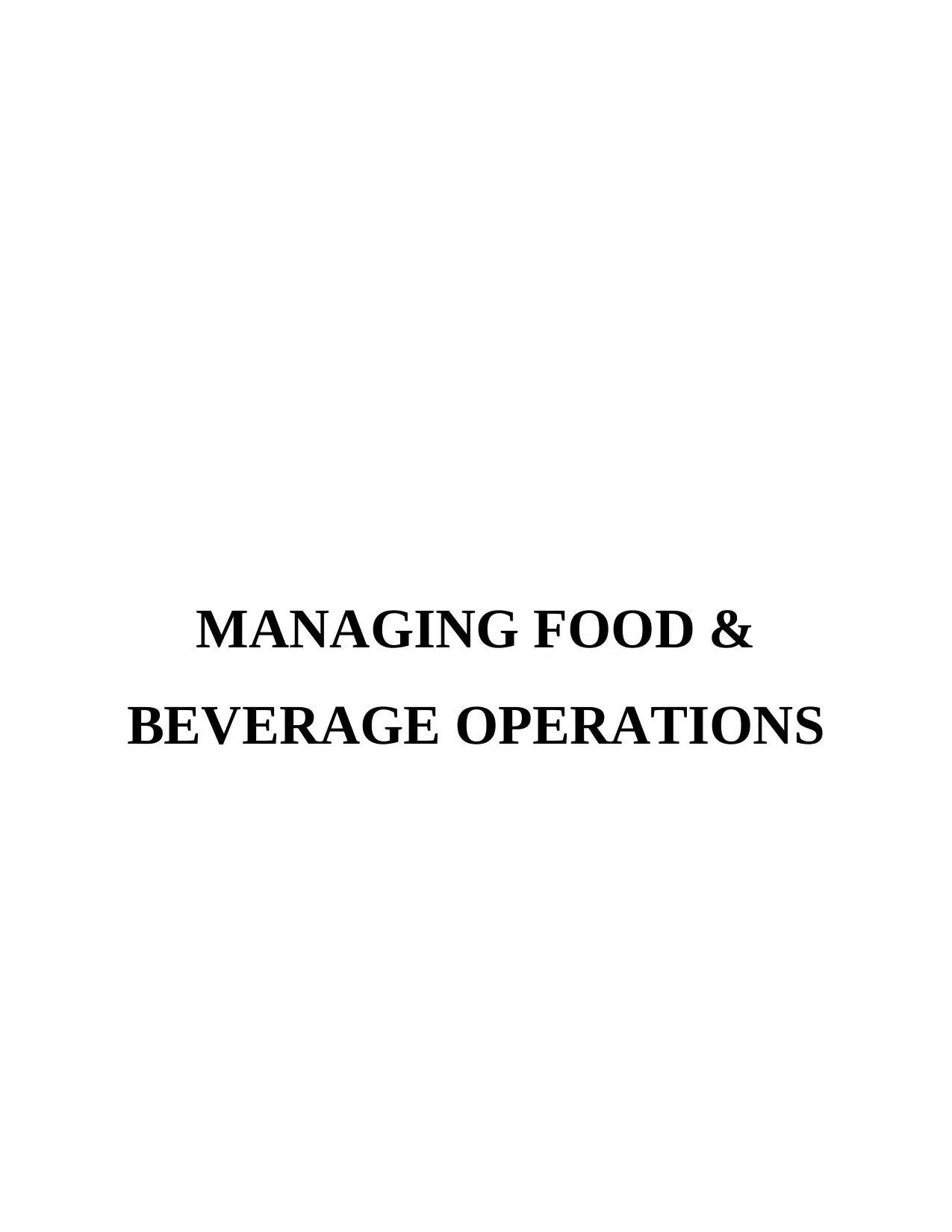
MANAGING FOOD &
BEVERAGE OPERATIONS
BEVERAGE OPERATIONS
Secure Best Marks with AI Grader
Need help grading? Try our AI Grader for instant feedback on your assignments.
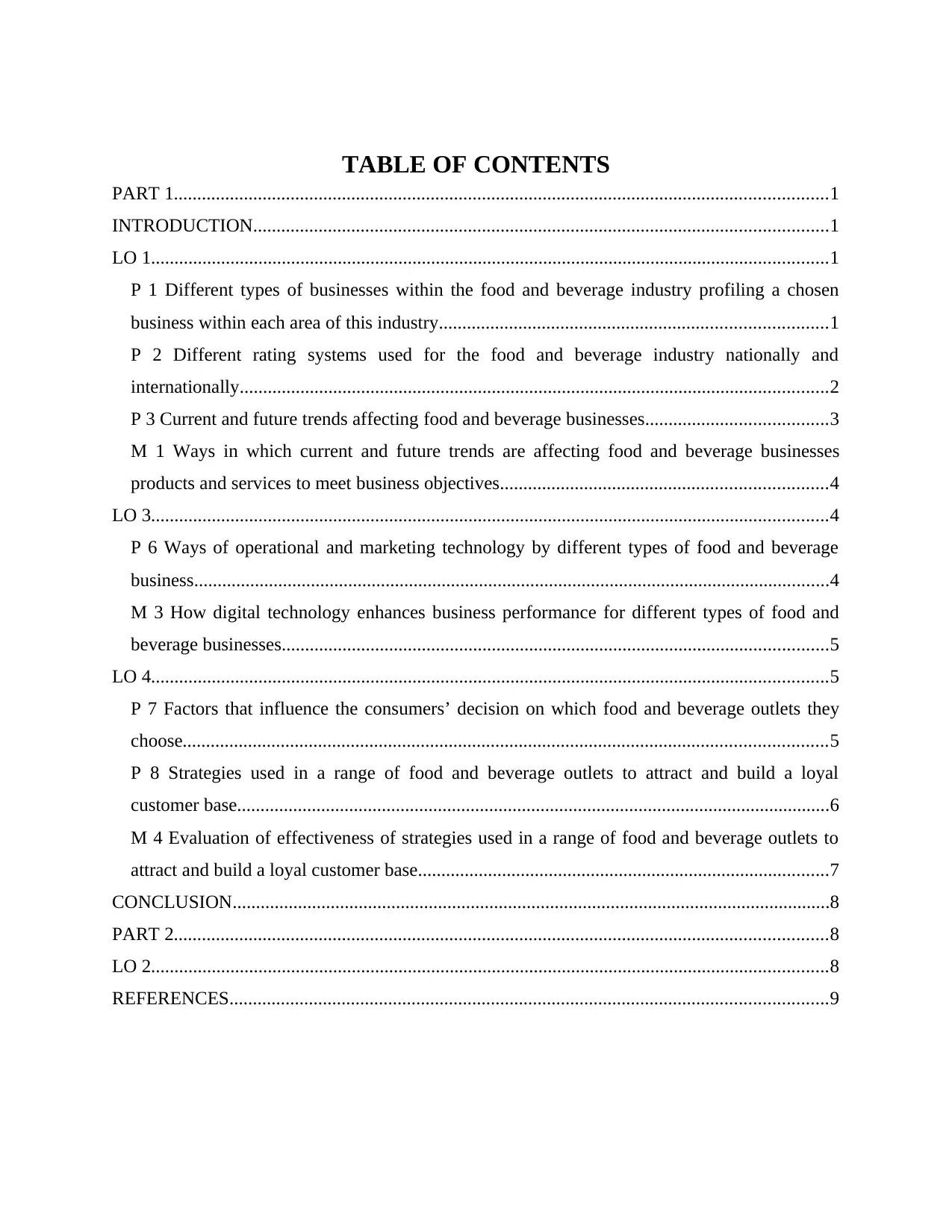
TABLE OF CONTENTS
PART 1............................................................................................................................................1
INTRODUCTION...........................................................................................................................1
LO 1.................................................................................................................................................1
P 1 Different types of businesses within the food and beverage industry profiling a chosen
business within each area of this industry...................................................................................1
P 2 Different rating systems used for the food and beverage industry nationally and
internationally..............................................................................................................................2
P 3 Current and future trends affecting food and beverage businesses.......................................3
M 1 Ways in which current and future trends are affecting food and beverage businesses
products and services to meet business objectives......................................................................4
LO 3.................................................................................................................................................4
P 6 Ways of operational and marketing technology by different types of food and beverage
business........................................................................................................................................4
M 3 How digital technology enhances business performance for different types of food and
beverage businesses.....................................................................................................................5
LO 4.................................................................................................................................................5
P 7 Factors that influence the consumers’ decision on which food and beverage outlets they
choose..........................................................................................................................................5
P 8 Strategies used in a range of food and beverage outlets to attract and build a loyal
customer base...............................................................................................................................6
M 4 Evaluation of effectiveness of strategies used in a range of food and beverage outlets to
attract and build a loyal customer base........................................................................................7
CONCLUSION................................................................................................................................8
PART 2............................................................................................................................................8
LO 2.................................................................................................................................................8
REFERENCES................................................................................................................................9
PART 1............................................................................................................................................1
INTRODUCTION...........................................................................................................................1
LO 1.................................................................................................................................................1
P 1 Different types of businesses within the food and beverage industry profiling a chosen
business within each area of this industry...................................................................................1
P 2 Different rating systems used for the food and beverage industry nationally and
internationally..............................................................................................................................2
P 3 Current and future trends affecting food and beverage businesses.......................................3
M 1 Ways in which current and future trends are affecting food and beverage businesses
products and services to meet business objectives......................................................................4
LO 3.................................................................................................................................................4
P 6 Ways of operational and marketing technology by different types of food and beverage
business........................................................................................................................................4
M 3 How digital technology enhances business performance for different types of food and
beverage businesses.....................................................................................................................5
LO 4.................................................................................................................................................5
P 7 Factors that influence the consumers’ decision on which food and beverage outlets they
choose..........................................................................................................................................5
P 8 Strategies used in a range of food and beverage outlets to attract and build a loyal
customer base...............................................................................................................................6
M 4 Evaluation of effectiveness of strategies used in a range of food and beverage outlets to
attract and build a loyal customer base........................................................................................7
CONCLUSION................................................................................................................................8
PART 2............................................................................................................................................8
LO 2.................................................................................................................................................8
REFERENCES................................................................................................................................9
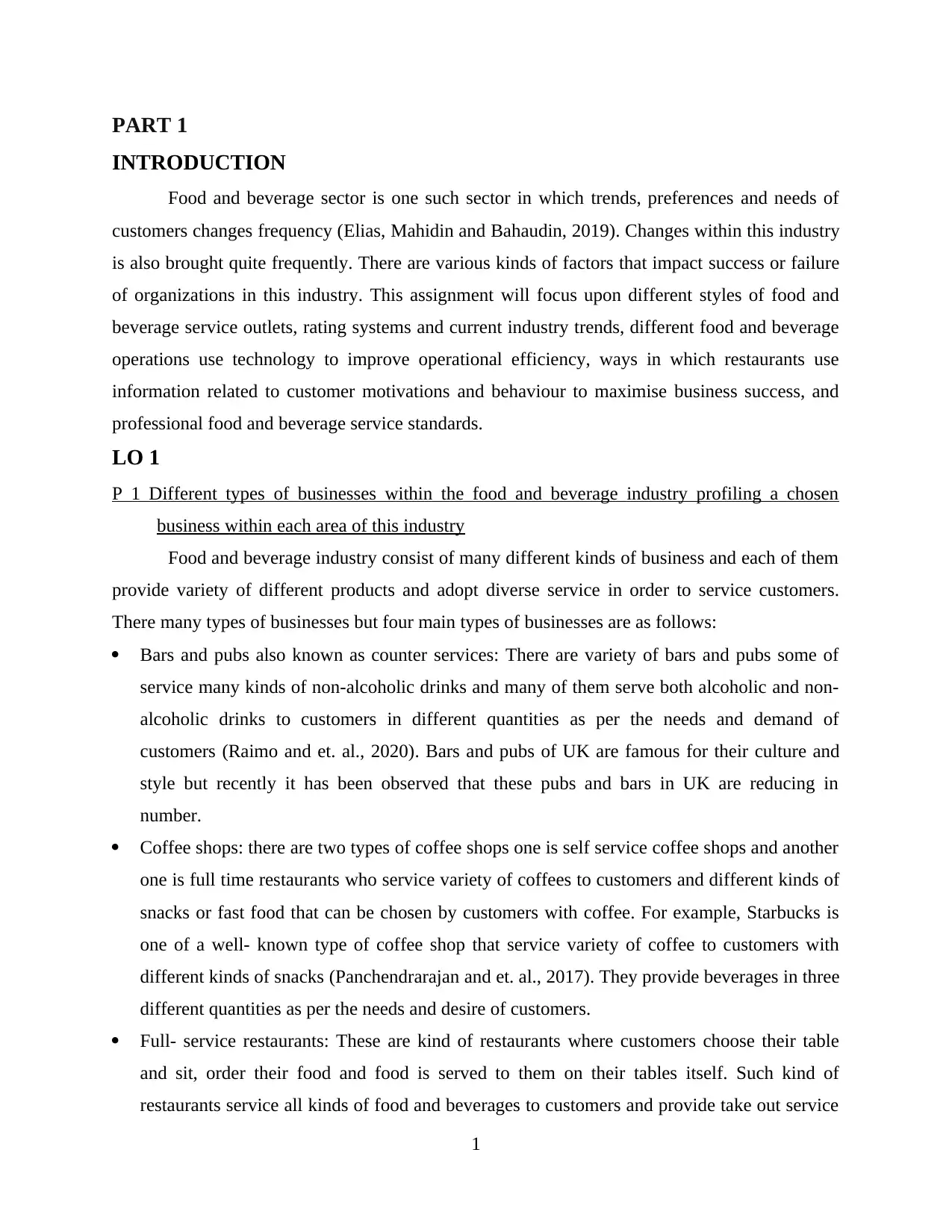
PART 1
INTRODUCTION
Food and beverage sector is one such sector in which trends, preferences and needs of
customers changes frequency (Elias, Mahidin and Bahaudin, 2019). Changes within this industry
is also brought quite frequently. There are various kinds of factors that impact success or failure
of organizations in this industry. This assignment will focus upon different styles of food and
beverage service outlets, rating systems and current industry trends, different food and beverage
operations use technology to improve operational efficiency, ways in which restaurants use
information related to customer motivations and behaviour to maximise business success, and
professional food and beverage service standards.
LO 1
P 1 Different types of businesses within the food and beverage industry profiling a chosen
business within each area of this industry
Food and beverage industry consist of many different kinds of business and each of them
provide variety of different products and adopt diverse service in order to service customers.
There many types of businesses but four main types of businesses are as follows:
Bars and pubs also known as counter services: There are variety of bars and pubs some of
service many kinds of non-alcoholic drinks and many of them serve both alcoholic and non-
alcoholic drinks to customers in different quantities as per the needs and demand of
customers (Raimo and et. al., 2020). Bars and pubs of UK are famous for their culture and
style but recently it has been observed that these pubs and bars in UK are reducing in
number.
Coffee shops: there are two types of coffee shops one is self service coffee shops and another
one is full time restaurants who service variety of coffees to customers and different kinds of
snacks or fast food that can be chosen by customers with coffee. For example, Starbucks is
one of a well- known type of coffee shop that service variety of coffee to customers with
different kinds of snacks (Panchendrarajan and et. al., 2017). They provide beverages in three
different quantities as per the needs and desire of customers.
Full- service restaurants: These are kind of restaurants where customers choose their table
and sit, order their food and food is served to them on their tables itself. Such kind of
restaurants service all kinds of food and beverages to customers and provide take out service
1
INTRODUCTION
Food and beverage sector is one such sector in which trends, preferences and needs of
customers changes frequency (Elias, Mahidin and Bahaudin, 2019). Changes within this industry
is also brought quite frequently. There are various kinds of factors that impact success or failure
of organizations in this industry. This assignment will focus upon different styles of food and
beverage service outlets, rating systems and current industry trends, different food and beverage
operations use technology to improve operational efficiency, ways in which restaurants use
information related to customer motivations and behaviour to maximise business success, and
professional food and beverage service standards.
LO 1
P 1 Different types of businesses within the food and beverage industry profiling a chosen
business within each area of this industry
Food and beverage industry consist of many different kinds of business and each of them
provide variety of different products and adopt diverse service in order to service customers.
There many types of businesses but four main types of businesses are as follows:
Bars and pubs also known as counter services: There are variety of bars and pubs some of
service many kinds of non-alcoholic drinks and many of them serve both alcoholic and non-
alcoholic drinks to customers in different quantities as per the needs and demand of
customers (Raimo and et. al., 2020). Bars and pubs of UK are famous for their culture and
style but recently it has been observed that these pubs and bars in UK are reducing in
number.
Coffee shops: there are two types of coffee shops one is self service coffee shops and another
one is full time restaurants who service variety of coffees to customers and different kinds of
snacks or fast food that can be chosen by customers with coffee. For example, Starbucks is
one of a well- known type of coffee shop that service variety of coffee to customers with
different kinds of snacks (Panchendrarajan and et. al., 2017). They provide beverages in three
different quantities as per the needs and desire of customers.
Full- service restaurants: These are kind of restaurants where customers choose their table
and sit, order their food and food is served to them on their tables itself. Such kind of
restaurants service all kinds of food and beverages to customers and provide take out service
1

as well. In this full- service restaurants, both fine dine in and casual dine in restaurants
comes. For example: Seven Park Place by William Drabble is a restaurant in London which
is a full service fine dine in restaurant.
Fast food restaurants or quick service restaurants: These kinds of restaurants who prepare
large quantity of food in bulk and then service it to customers quickly as per their need and
demand (Dunford and et. al., 2017). Fast food restaurants are one of the categories of quick
service restaurant. For example, London fast food (Brixton) is a kind of fast- food restaurant
in London.
P 2 Different rating systems used for the food and beverage industry nationally and
internationally
Rating system is a kind of a grading system which is used to rate overall quality of
products and services provided by organizations. In food and beverage industry there are various
kinds of rating systems that are used to rate organizations in this industry. These ratings help in
developing or maintaining overall brand image of restaurants or outlets as per experience of
customers, and quality of food products and services that are provide to customers. Some of the
types of rating system most commonly used in food and beverage industry are as follows:
Michelin Star: It is a series of guide book that was published by a French company named as
Michelin more than a century ago. This guide is published every year by oldest European
hotel as a guide for awarding up to Michelin starts of restaurants or outlets in this industry
(Ivkov and et. al., 2018). It is one of the most prestigious type of honour which is provided to
organization and losing even a single Michelin star can impact overall brand image of
company operating in this industry. One Michelin star means good, two Michelin star means
exceptional and three Michelin star means exquisite. There is a possibility of gaining or
losing exquisite cuisine star if there is any kind of change in menu or organization change
their head chef.
Scores on the Doors: It is a kind of rating which is given by food standard agency. This
rating is majorly given on the basis of hygiene level maintained by outlets or restaurants
(Farvazova, 2020). As per this rating system of a restaurant is given 5 rating then that means
their hygiene standard is very good and if a restaurant is given 0 rating then that means
urgent improvement is required.
2
comes. For example: Seven Park Place by William Drabble is a restaurant in London which
is a full service fine dine in restaurant.
Fast food restaurants or quick service restaurants: These kinds of restaurants who prepare
large quantity of food in bulk and then service it to customers quickly as per their need and
demand (Dunford and et. al., 2017). Fast food restaurants are one of the categories of quick
service restaurant. For example, London fast food (Brixton) is a kind of fast- food restaurant
in London.
P 2 Different rating systems used for the food and beverage industry nationally and
internationally
Rating system is a kind of a grading system which is used to rate overall quality of
products and services provided by organizations. In food and beverage industry there are various
kinds of rating systems that are used to rate organizations in this industry. These ratings help in
developing or maintaining overall brand image of restaurants or outlets as per experience of
customers, and quality of food products and services that are provide to customers. Some of the
types of rating system most commonly used in food and beverage industry are as follows:
Michelin Star: It is a series of guide book that was published by a French company named as
Michelin more than a century ago. This guide is published every year by oldest European
hotel as a guide for awarding up to Michelin starts of restaurants or outlets in this industry
(Ivkov and et. al., 2018). It is one of the most prestigious type of honour which is provided to
organization and losing even a single Michelin star can impact overall brand image of
company operating in this industry. One Michelin star means good, two Michelin star means
exceptional and three Michelin star means exquisite. There is a possibility of gaining or
losing exquisite cuisine star if there is any kind of change in menu or organization change
their head chef.
Scores on the Doors: It is a kind of rating which is given by food standard agency. This
rating is majorly given on the basis of hygiene level maintained by outlets or restaurants
(Farvazova, 2020). As per this rating system of a restaurant is given 5 rating then that means
their hygiene standard is very good and if a restaurant is given 0 rating then that means
urgent improvement is required.
2
Secure Best Marks with AI Grader
Need help grading? Try our AI Grader for instant feedback on your assignments.
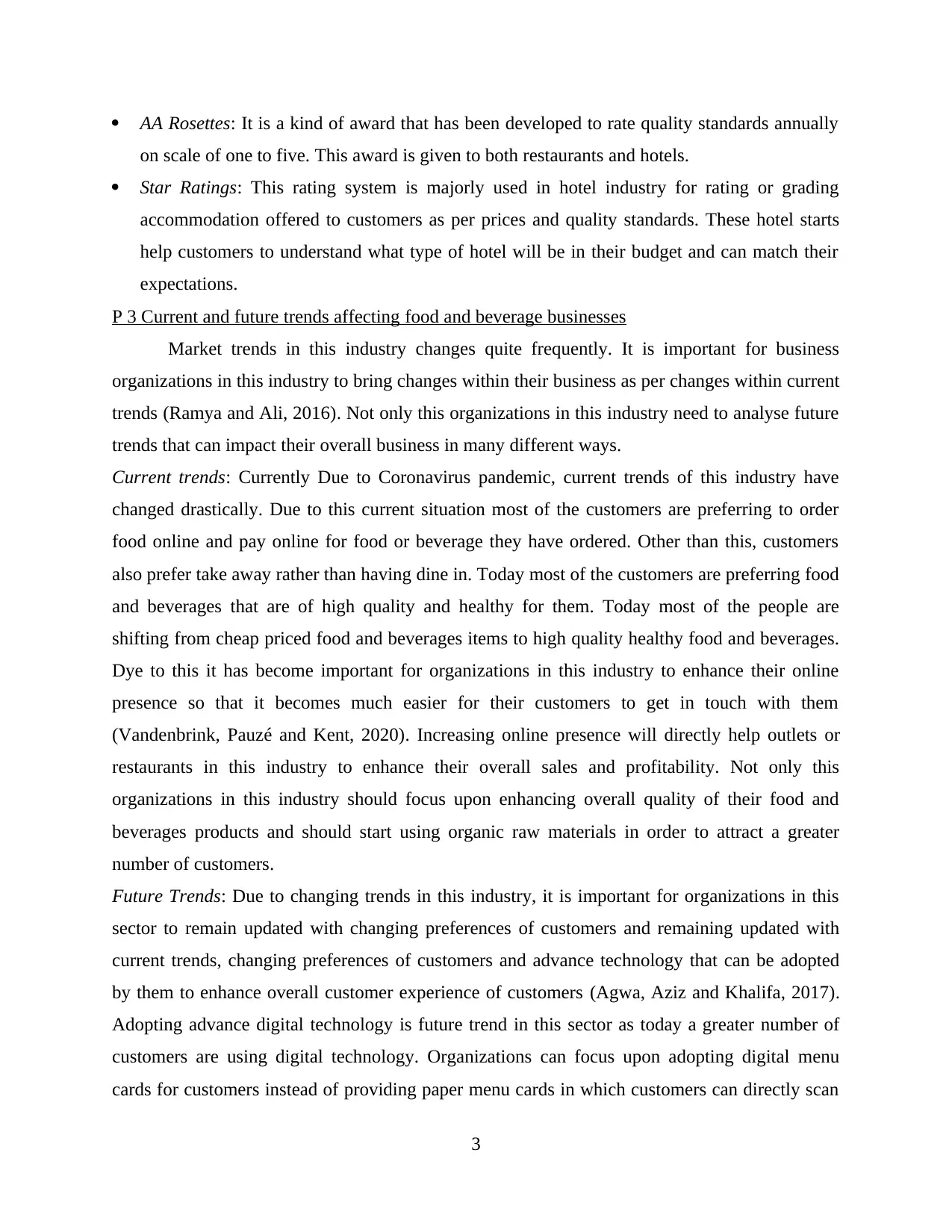
AA Rosettes: It is a kind of award that has been developed to rate quality standards annually
on scale of one to five. This award is given to both restaurants and hotels.
Star Ratings: This rating system is majorly used in hotel industry for rating or grading
accommodation offered to customers as per prices and quality standards. These hotel starts
help customers to understand what type of hotel will be in their budget and can match their
expectations.
P 3 Current and future trends affecting food and beverage businesses
Market trends in this industry changes quite frequently. It is important for business
organizations in this industry to bring changes within their business as per changes within current
trends (Ramya and Ali, 2016). Not only this organizations in this industry need to analyse future
trends that can impact their overall business in many different ways.
Current trends: Currently Due to Coronavirus pandemic, current trends of this industry have
changed drastically. Due to this current situation most of the customers are preferring to order
food online and pay online for food or beverage they have ordered. Other than this, customers
also prefer take away rather than having dine in. Today most of the customers are preferring food
and beverages that are of high quality and healthy for them. Today most of the people are
shifting from cheap priced food and beverages items to high quality healthy food and beverages.
Dye to this it has become important for organizations in this industry to enhance their online
presence so that it becomes much easier for their customers to get in touch with them
(Vandenbrink, Pauzé and Kent, 2020). Increasing online presence will directly help outlets or
restaurants in this industry to enhance their overall sales and profitability. Not only this
organizations in this industry should focus upon enhancing overall quality of their food and
beverages products and should start using organic raw materials in order to attract a greater
number of customers.
Future Trends: Due to changing trends in this industry, it is important for organizations in this
sector to remain updated with changing preferences of customers and remaining updated with
current trends, changing preferences of customers and advance technology that can be adopted
by them to enhance overall customer experience of customers (Agwa, Aziz and Khalifa, 2017).
Adopting advance digital technology is future trend in this sector as today a greater number of
customers are using digital technology. Organizations can focus upon adopting digital menu
cards for customers instead of providing paper menu cards in which customers can directly scan
3
on scale of one to five. This award is given to both restaurants and hotels.
Star Ratings: This rating system is majorly used in hotel industry for rating or grading
accommodation offered to customers as per prices and quality standards. These hotel starts
help customers to understand what type of hotel will be in their budget and can match their
expectations.
P 3 Current and future trends affecting food and beverage businesses
Market trends in this industry changes quite frequently. It is important for business
organizations in this industry to bring changes within their business as per changes within current
trends (Ramya and Ali, 2016). Not only this organizations in this industry need to analyse future
trends that can impact their overall business in many different ways.
Current trends: Currently Due to Coronavirus pandemic, current trends of this industry have
changed drastically. Due to this current situation most of the customers are preferring to order
food online and pay online for food or beverage they have ordered. Other than this, customers
also prefer take away rather than having dine in. Today most of the customers are preferring food
and beverages that are of high quality and healthy for them. Today most of the people are
shifting from cheap priced food and beverages items to high quality healthy food and beverages.
Dye to this it has become important for organizations in this industry to enhance their online
presence so that it becomes much easier for their customers to get in touch with them
(Vandenbrink, Pauzé and Kent, 2020). Increasing online presence will directly help outlets or
restaurants in this industry to enhance their overall sales and profitability. Not only this
organizations in this industry should focus upon enhancing overall quality of their food and
beverages products and should start using organic raw materials in order to attract a greater
number of customers.
Future Trends: Due to changing trends in this industry, it is important for organizations in this
sector to remain updated with changing preferences of customers and remaining updated with
current trends, changing preferences of customers and advance technology that can be adopted
by them to enhance overall customer experience of customers (Agwa, Aziz and Khalifa, 2017).
Adopting advance digital technology is future trend in this sector as today a greater number of
customers are using digital technology. Organizations can focus upon adopting digital menu
cards for customers instead of providing paper menu cards in which customers can directly scan
3
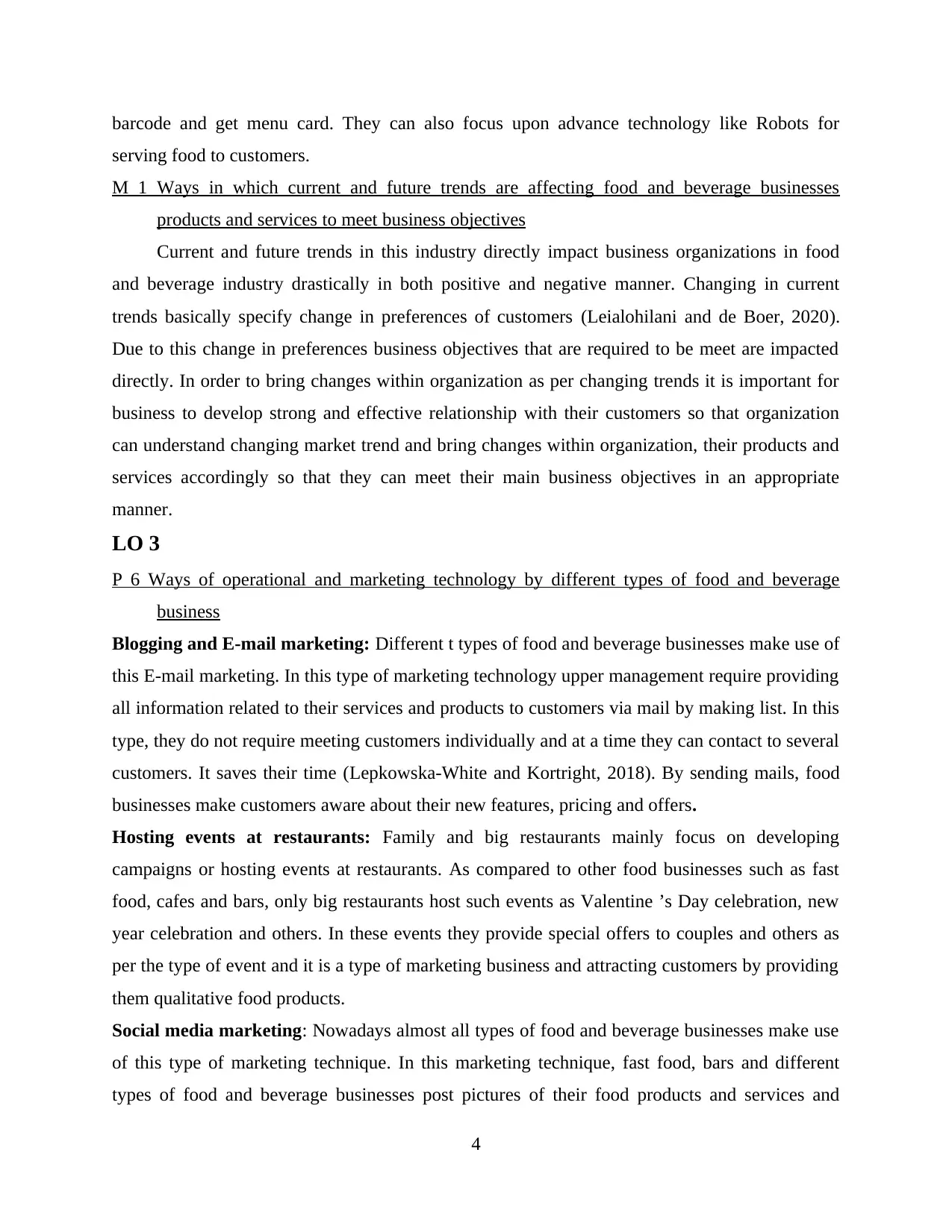
barcode and get menu card. They can also focus upon advance technology like Robots for
serving food to customers.
M 1 Ways in which current and future trends are affecting food and beverage businesses
products and services to meet business objectives
Current and future trends in this industry directly impact business organizations in food
and beverage industry drastically in both positive and negative manner. Changing in current
trends basically specify change in preferences of customers (Leialohilani and de Boer, 2020).
Due to this change in preferences business objectives that are required to be meet are impacted
directly. In order to bring changes within organization as per changing trends it is important for
business to develop strong and effective relationship with their customers so that organization
can understand changing market trend and bring changes within organization, their products and
services accordingly so that they can meet their main business objectives in an appropriate
manner.
LO 3
P 6 Ways of operational and marketing technology by different types of food and beverage
business
Blogging and E-mail marketing: Different t types of food and beverage businesses make use of
this E-mail marketing. In this type of marketing technology upper management require providing
all information related to their services and products to customers via mail by making list. In this
type, they do not require meeting customers individually and at a time they can contact to several
customers. It saves their time (Lepkowska-White and Kortright, 2018). By sending mails, food
businesses make customers aware about their new features, pricing and offers.
Hosting events at restaurants: Family and big restaurants mainly focus on developing
campaigns or hosting events at restaurants. As compared to other food businesses such as fast
food, cafes and bars, only big restaurants host such events as Valentine ’s Day celebration, new
year celebration and others. In these events they provide special offers to couples and others as
per the type of event and it is a type of marketing business and attracting customers by providing
them qualitative food products.
Social media marketing: Nowadays almost all types of food and beverage businesses make use
of this type of marketing technique. In this marketing technique, fast food, bars and different
types of food and beverage businesses post pictures of their food products and services and
4
serving food to customers.
M 1 Ways in which current and future trends are affecting food and beverage businesses
products and services to meet business objectives
Current and future trends in this industry directly impact business organizations in food
and beverage industry drastically in both positive and negative manner. Changing in current
trends basically specify change in preferences of customers (Leialohilani and de Boer, 2020).
Due to this change in preferences business objectives that are required to be meet are impacted
directly. In order to bring changes within organization as per changing trends it is important for
business to develop strong and effective relationship with their customers so that organization
can understand changing market trend and bring changes within organization, their products and
services accordingly so that they can meet their main business objectives in an appropriate
manner.
LO 3
P 6 Ways of operational and marketing technology by different types of food and beverage
business
Blogging and E-mail marketing: Different t types of food and beverage businesses make use of
this E-mail marketing. In this type of marketing technology upper management require providing
all information related to their services and products to customers via mail by making list. In this
type, they do not require meeting customers individually and at a time they can contact to several
customers. It saves their time (Lepkowska-White and Kortright, 2018). By sending mails, food
businesses make customers aware about their new features, pricing and offers.
Hosting events at restaurants: Family and big restaurants mainly focus on developing
campaigns or hosting events at restaurants. As compared to other food businesses such as fast
food, cafes and bars, only big restaurants host such events as Valentine ’s Day celebration, new
year celebration and others. In these events they provide special offers to couples and others as
per the type of event and it is a type of marketing business and attracting customers by providing
them qualitative food products.
Social media marketing: Nowadays almost all types of food and beverage businesses make use
of this type of marketing technique. In this marketing technique, fast food, bars and different
types of food and beverage businesses post pictures of their food products and services and
4
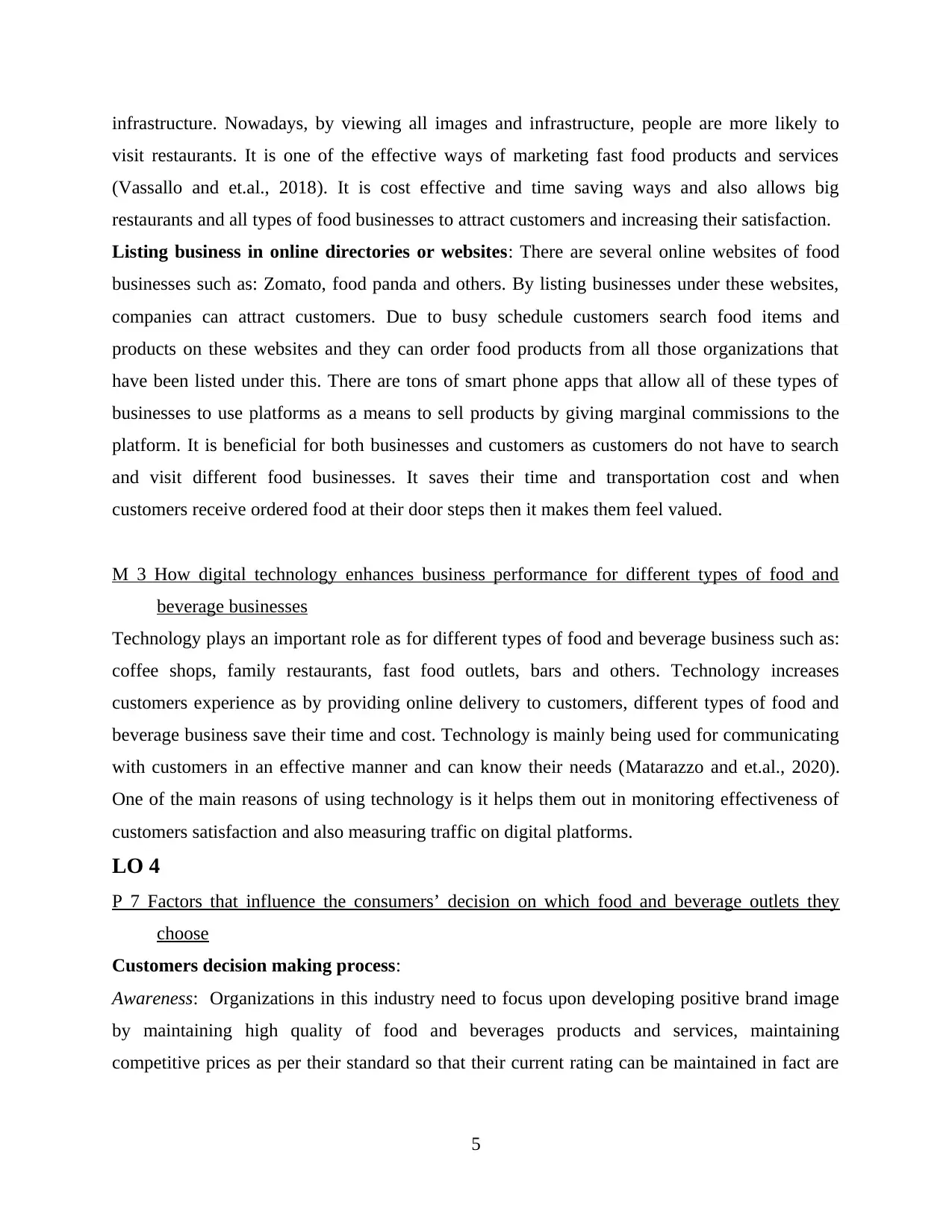
infrastructure. Nowadays, by viewing all images and infrastructure, people are more likely to
visit restaurants. It is one of the effective ways of marketing fast food products and services
(Vassallo and et.al., 2018). It is cost effective and time saving ways and also allows big
restaurants and all types of food businesses to attract customers and increasing their satisfaction.
Listing business in online directories or websites: There are several online websites of food
businesses such as: Zomato, food panda and others. By listing businesses under these websites,
companies can attract customers. Due to busy schedule customers search food items and
products on these websites and they can order food products from all those organizations that
have been listed under this. There are tons of smart phone apps that allow all of these types of
businesses to use platforms as a means to sell products by giving marginal commissions to the
platform. It is beneficial for both businesses and customers as customers do not have to search
and visit different food businesses. It saves their time and transportation cost and when
customers receive ordered food at their door steps then it makes them feel valued.
M 3 How digital technology enhances business performance for different types of food and
beverage businesses
Technology plays an important role as for different types of food and beverage business such as:
coffee shops, family restaurants, fast food outlets, bars and others. Technology increases
customers experience as by providing online delivery to customers, different types of food and
beverage business save their time and cost. Technology is mainly being used for communicating
with customers in an effective manner and can know their needs (Matarazzo and et.al., 2020).
One of the main reasons of using technology is it helps them out in monitoring effectiveness of
customers satisfaction and also measuring traffic on digital platforms.
LO 4
P 7 Factors that influence the consumers’ decision on which food and beverage outlets they
choose
Customers decision making process:
Awareness: Organizations in this industry need to focus upon developing positive brand image
by maintaining high quality of food and beverages products and services, maintaining
competitive prices as per their standard so that their current rating can be maintained in fact are
5
visit restaurants. It is one of the effective ways of marketing fast food products and services
(Vassallo and et.al., 2018). It is cost effective and time saving ways and also allows big
restaurants and all types of food businesses to attract customers and increasing their satisfaction.
Listing business in online directories or websites: There are several online websites of food
businesses such as: Zomato, food panda and others. By listing businesses under these websites,
companies can attract customers. Due to busy schedule customers search food items and
products on these websites and they can order food products from all those organizations that
have been listed under this. There are tons of smart phone apps that allow all of these types of
businesses to use platforms as a means to sell products by giving marginal commissions to the
platform. It is beneficial for both businesses and customers as customers do not have to search
and visit different food businesses. It saves their time and transportation cost and when
customers receive ordered food at their door steps then it makes them feel valued.
M 3 How digital technology enhances business performance for different types of food and
beverage businesses
Technology plays an important role as for different types of food and beverage business such as:
coffee shops, family restaurants, fast food outlets, bars and others. Technology increases
customers experience as by providing online delivery to customers, different types of food and
beverage business save their time and cost. Technology is mainly being used for communicating
with customers in an effective manner and can know their needs (Matarazzo and et.al., 2020).
One of the main reasons of using technology is it helps them out in monitoring effectiveness of
customers satisfaction and also measuring traffic on digital platforms.
LO 4
P 7 Factors that influence the consumers’ decision on which food and beverage outlets they
choose
Customers decision making process:
Awareness: Organizations in this industry need to focus upon developing positive brand image
by maintaining high quality of food and beverages products and services, maintaining
competitive prices as per their standard so that their current rating can be maintained in fact are
5
Paraphrase This Document
Need a fresh take? Get an instant paraphrase of this document with our AI Paraphraser
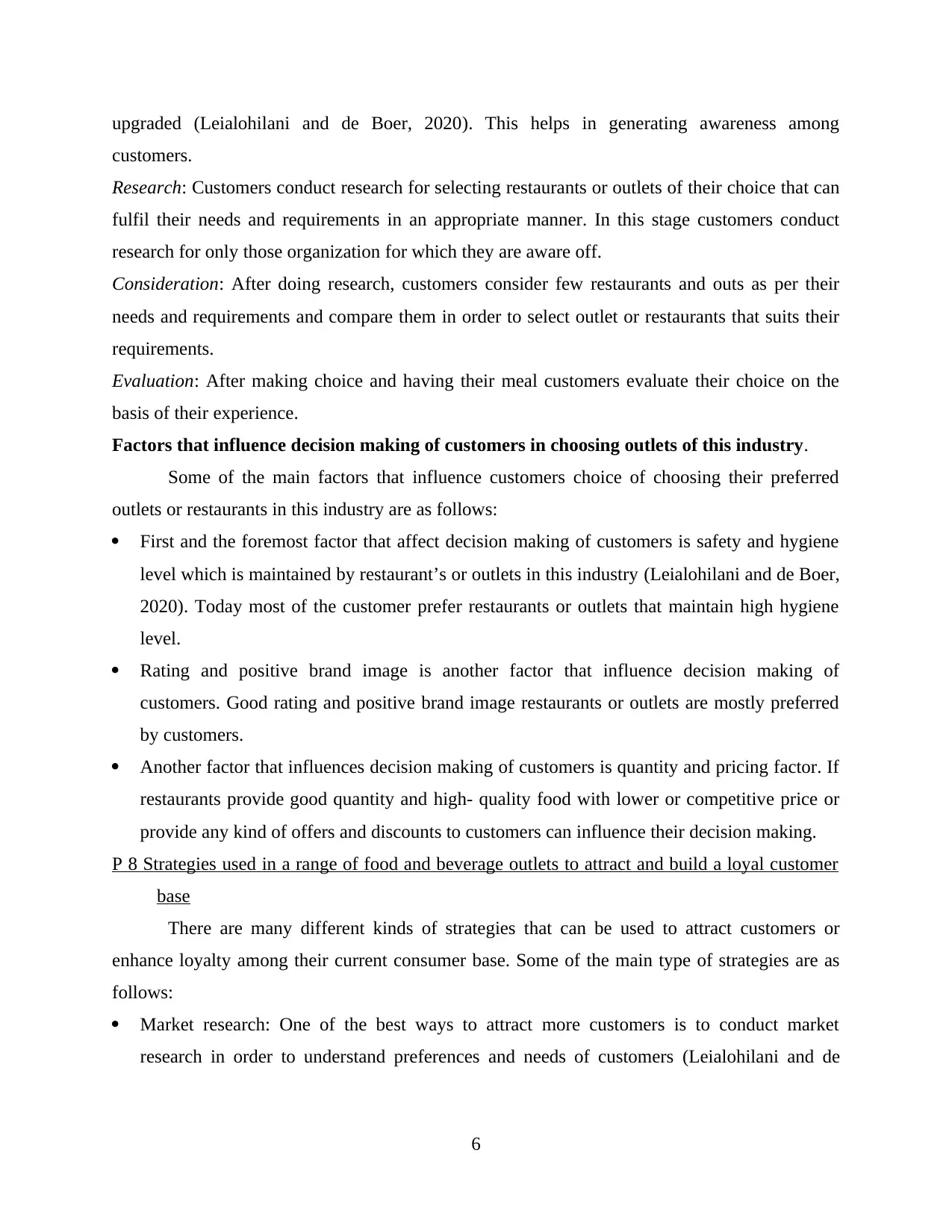
upgraded (Leialohilani and de Boer, 2020). This helps in generating awareness among
customers.
Research: Customers conduct research for selecting restaurants or outlets of their choice that can
fulfil their needs and requirements in an appropriate manner. In this stage customers conduct
research for only those organization for which they are aware off.
Consideration: After doing research, customers consider few restaurants and outs as per their
needs and requirements and compare them in order to select outlet or restaurants that suits their
requirements.
Evaluation: After making choice and having their meal customers evaluate their choice on the
basis of their experience.
Factors that influence decision making of customers in choosing outlets of this industry.
Some of the main factors that influence customers choice of choosing their preferred
outlets or restaurants in this industry are as follows:
First and the foremost factor that affect decision making of customers is safety and hygiene
level which is maintained by restaurant’s or outlets in this industry (Leialohilani and de Boer,
2020). Today most of the customer prefer restaurants or outlets that maintain high hygiene
level.
Rating and positive brand image is another factor that influence decision making of
customers. Good rating and positive brand image restaurants or outlets are mostly preferred
by customers.
Another factor that influences decision making of customers is quantity and pricing factor. If
restaurants provide good quantity and high- quality food with lower or competitive price or
provide any kind of offers and discounts to customers can influence their decision making.
P 8 Strategies used in a range of food and beverage outlets to attract and build a loyal customer
base
There are many different kinds of strategies that can be used to attract customers or
enhance loyalty among their current consumer base. Some of the main type of strategies are as
follows:
Market research: One of the best ways to attract more customers is to conduct market
research in order to understand preferences and needs of customers (Leialohilani and de
6
customers.
Research: Customers conduct research for selecting restaurants or outlets of their choice that can
fulfil their needs and requirements in an appropriate manner. In this stage customers conduct
research for only those organization for which they are aware off.
Consideration: After doing research, customers consider few restaurants and outs as per their
needs and requirements and compare them in order to select outlet or restaurants that suits their
requirements.
Evaluation: After making choice and having their meal customers evaluate their choice on the
basis of their experience.
Factors that influence decision making of customers in choosing outlets of this industry.
Some of the main factors that influence customers choice of choosing their preferred
outlets or restaurants in this industry are as follows:
First and the foremost factor that affect decision making of customers is safety and hygiene
level which is maintained by restaurant’s or outlets in this industry (Leialohilani and de Boer,
2020). Today most of the customer prefer restaurants or outlets that maintain high hygiene
level.
Rating and positive brand image is another factor that influence decision making of
customers. Good rating and positive brand image restaurants or outlets are mostly preferred
by customers.
Another factor that influences decision making of customers is quantity and pricing factor. If
restaurants provide good quantity and high- quality food with lower or competitive price or
provide any kind of offers and discounts to customers can influence their decision making.
P 8 Strategies used in a range of food and beverage outlets to attract and build a loyal customer
base
There are many different kinds of strategies that can be used to attract customers or
enhance loyalty among their current consumer base. Some of the main type of strategies are as
follows:
Market research: One of the best ways to attract more customers is to conduct market
research in order to understand preferences and needs of customers (Leialohilani and de
6
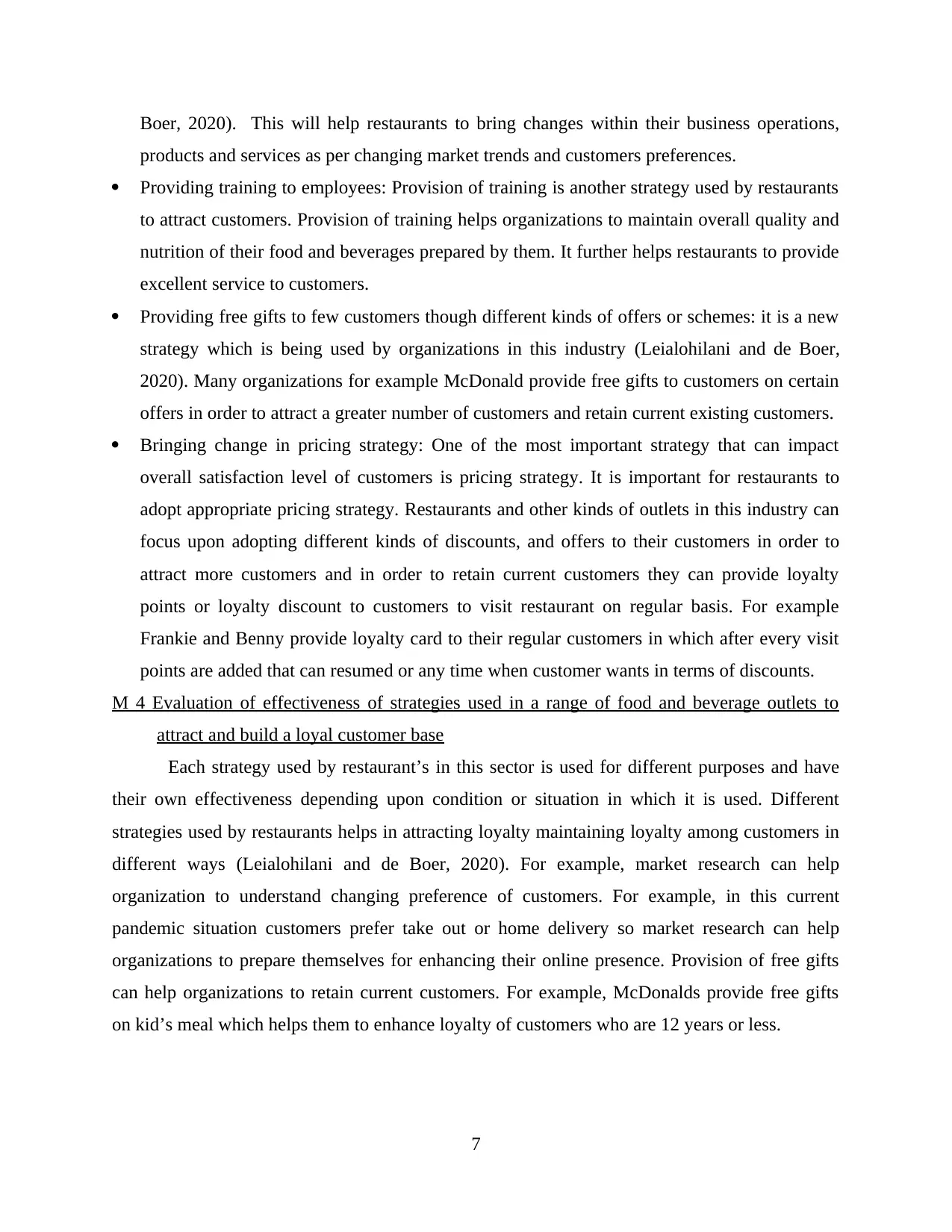
Boer, 2020). This will help restaurants to bring changes within their business operations,
products and services as per changing market trends and customers preferences.
Providing training to employees: Provision of training is another strategy used by restaurants
to attract customers. Provision of training helps organizations to maintain overall quality and
nutrition of their food and beverages prepared by them. It further helps restaurants to provide
excellent service to customers.
Providing free gifts to few customers though different kinds of offers or schemes: it is a new
strategy which is being used by organizations in this industry (Leialohilani and de Boer,
2020). Many organizations for example McDonald provide free gifts to customers on certain
offers in order to attract a greater number of customers and retain current existing customers.
Bringing change in pricing strategy: One of the most important strategy that can impact
overall satisfaction level of customers is pricing strategy. It is important for restaurants to
adopt appropriate pricing strategy. Restaurants and other kinds of outlets in this industry can
focus upon adopting different kinds of discounts, and offers to their customers in order to
attract more customers and in order to retain current customers they can provide loyalty
points or loyalty discount to customers to visit restaurant on regular basis. For example
Frankie and Benny provide loyalty card to their regular customers in which after every visit
points are added that can resumed or any time when customer wants in terms of discounts.
M 4 Evaluation of effectiveness of strategies used in a range of food and beverage outlets to
attract and build a loyal customer base
Each strategy used by restaurant’s in this sector is used for different purposes and have
their own effectiveness depending upon condition or situation in which it is used. Different
strategies used by restaurants helps in attracting loyalty maintaining loyalty among customers in
different ways (Leialohilani and de Boer, 2020). For example, market research can help
organization to understand changing preference of customers. For example, in this current
pandemic situation customers prefer take out or home delivery so market research can help
organizations to prepare themselves for enhancing their online presence. Provision of free gifts
can help organizations to retain current customers. For example, McDonalds provide free gifts
on kid’s meal which helps them to enhance loyalty of customers who are 12 years or less.
7
products and services as per changing market trends and customers preferences.
Providing training to employees: Provision of training is another strategy used by restaurants
to attract customers. Provision of training helps organizations to maintain overall quality and
nutrition of their food and beverages prepared by them. It further helps restaurants to provide
excellent service to customers.
Providing free gifts to few customers though different kinds of offers or schemes: it is a new
strategy which is being used by organizations in this industry (Leialohilani and de Boer,
2020). Many organizations for example McDonald provide free gifts to customers on certain
offers in order to attract a greater number of customers and retain current existing customers.
Bringing change in pricing strategy: One of the most important strategy that can impact
overall satisfaction level of customers is pricing strategy. It is important for restaurants to
adopt appropriate pricing strategy. Restaurants and other kinds of outlets in this industry can
focus upon adopting different kinds of discounts, and offers to their customers in order to
attract more customers and in order to retain current customers they can provide loyalty
points or loyalty discount to customers to visit restaurant on regular basis. For example
Frankie and Benny provide loyalty card to their regular customers in which after every visit
points are added that can resumed or any time when customer wants in terms of discounts.
M 4 Evaluation of effectiveness of strategies used in a range of food and beverage outlets to
attract and build a loyal customer base
Each strategy used by restaurant’s in this sector is used for different purposes and have
their own effectiveness depending upon condition or situation in which it is used. Different
strategies used by restaurants helps in attracting loyalty maintaining loyalty among customers in
different ways (Leialohilani and de Boer, 2020). For example, market research can help
organization to understand changing preference of customers. For example, in this current
pandemic situation customers prefer take out or home delivery so market research can help
organizations to prepare themselves for enhancing their online presence. Provision of free gifts
can help organizations to retain current customers. For example, McDonalds provide free gifts
on kid’s meal which helps them to enhance loyalty of customers who are 12 years or less.
7

CONCLUSION
From the above assignment it has been summarized that there are various kinds of
strategies that can be used by organizations in this sector for retaining their current customers
and enhancing their overall customer base. It is important for organizations in this industry to
focus upon adopting appropriate strategies for retaining customers in order to enhance their
overall sales and profitability. It has also been concluded that it is important for organization of
this industry to remain updated with current and future trends as change in these trends can make
it difficult for organization to achieve their desired goals and objectives in an accurate manner.
PART 2
LO 2
Covered in presentation
8
From the above assignment it has been summarized that there are various kinds of
strategies that can be used by organizations in this sector for retaining their current customers
and enhancing their overall customer base. It is important for organizations in this industry to
focus upon adopting appropriate strategies for retaining customers in order to enhance their
overall sales and profitability. It has also been concluded that it is important for organization of
this industry to remain updated with current and future trends as change in these trends can make
it difficult for organization to achieve their desired goals and objectives in an accurate manner.
PART 2
LO 2
Covered in presentation
8
Secure Best Marks with AI Grader
Need help grading? Try our AI Grader for instant feedback on your assignments.
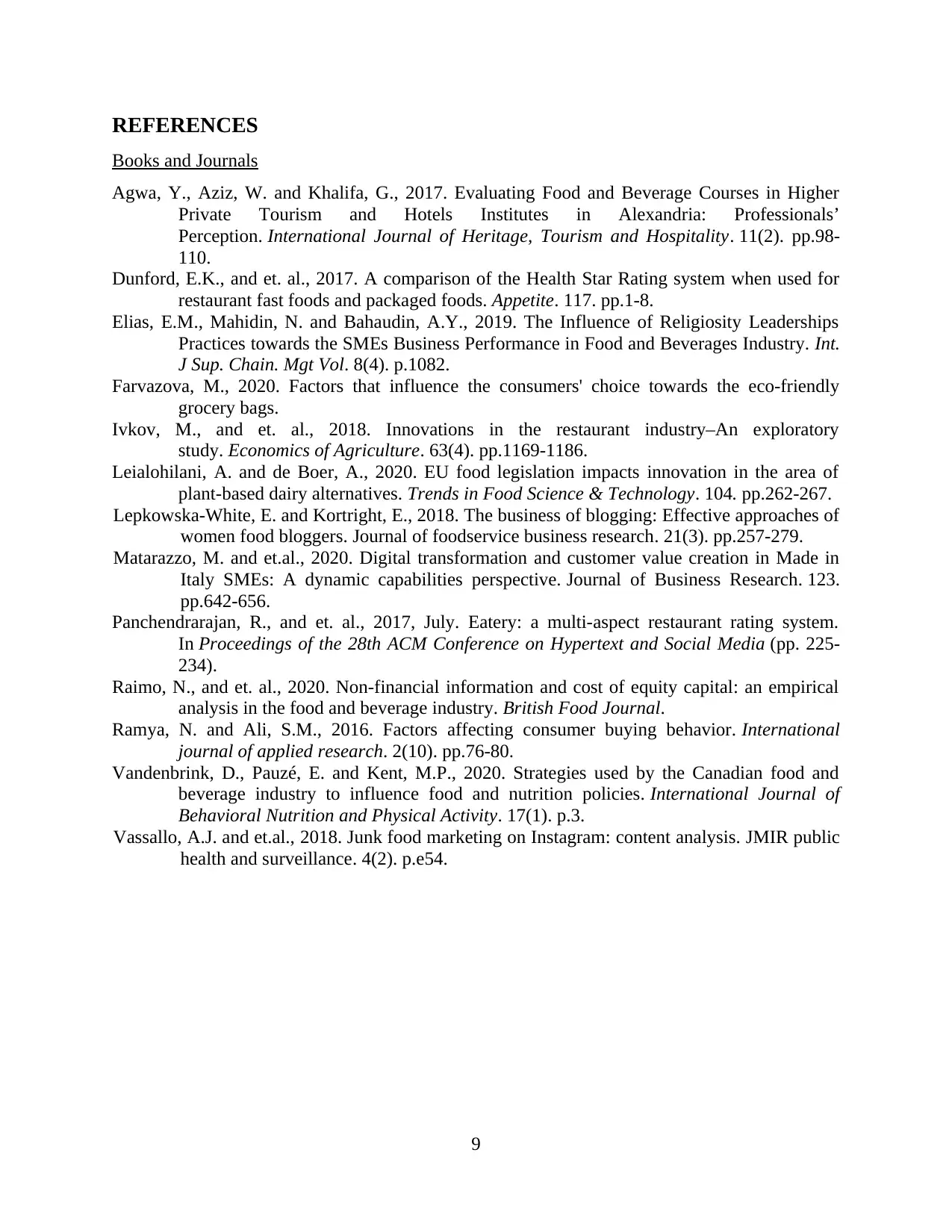
REFERENCES
Books and Journals
Agwa, Y., Aziz, W. and Khalifa, G., 2017. Evaluating Food and Beverage Courses in Higher
Private Tourism and Hotels Institutes in Alexandria: Professionals’
Perception. International Journal of Heritage, Tourism and Hospitality. 11(2). pp.98-
110.
Dunford, E.K., and et. al., 2017. A comparison of the Health Star Rating system when used for
restaurant fast foods and packaged foods. Appetite. 117. pp.1-8.
Elias, E.M., Mahidin, N. and Bahaudin, A.Y., 2019. The Influence of Religiosity Leaderships
Practices towards the SMEs Business Performance in Food and Beverages Industry. Int.
J Sup. Chain. Mgt Vol. 8(4). p.1082.
Farvazova, M., 2020. Factors that influence the consumers' choice towards the eco-friendly
grocery bags.
Ivkov, M., and et. al., 2018. Innovations in the restaurant industry–An exploratory
study. Economics of Agriculture. 63(4). pp.1169-1186.
Leialohilani, A. and de Boer, A., 2020. EU food legislation impacts innovation in the area of
plant-based dairy alternatives. Trends in Food Science & Technology. 104. pp.262-267.
Lepkowska-White, E. and Kortright, E., 2018. The business of blogging: Effective approaches of
women food bloggers. Journal of foodservice business research. 21(3). pp.257-279.
Matarazzo, M. and et.al., 2020. Digital transformation and customer value creation in Made in
Italy SMEs: A dynamic capabilities perspective. Journal of Business Research. 123.
pp.642-656.
Panchendrarajan, R., and et. al., 2017, July. Eatery: a multi-aspect restaurant rating system.
In Proceedings of the 28th ACM Conference on Hypertext and Social Media (pp. 225-
234).
Raimo, N., and et. al., 2020. Non-financial information and cost of equity capital: an empirical
analysis in the food and beverage industry. British Food Journal.
Ramya, N. and Ali, S.M., 2016. Factors affecting consumer buying behavior. International
journal of applied research. 2(10). pp.76-80.
Vandenbrink, D., Pauzé, E. and Kent, M.P., 2020. Strategies used by the Canadian food and
beverage industry to influence food and nutrition policies. International Journal of
Behavioral Nutrition and Physical Activity. 17(1). p.3.
Vassallo, A.J. and et.al., 2018. Junk food marketing on Instagram: content analysis. JMIR public
health and surveillance. 4(2). p.e54.
9
Books and Journals
Agwa, Y., Aziz, W. and Khalifa, G., 2017. Evaluating Food and Beverage Courses in Higher
Private Tourism and Hotels Institutes in Alexandria: Professionals’
Perception. International Journal of Heritage, Tourism and Hospitality. 11(2). pp.98-
110.
Dunford, E.K., and et. al., 2017. A comparison of the Health Star Rating system when used for
restaurant fast foods and packaged foods. Appetite. 117. pp.1-8.
Elias, E.M., Mahidin, N. and Bahaudin, A.Y., 2019. The Influence of Religiosity Leaderships
Practices towards the SMEs Business Performance in Food and Beverages Industry. Int.
J Sup. Chain. Mgt Vol. 8(4). p.1082.
Farvazova, M., 2020. Factors that influence the consumers' choice towards the eco-friendly
grocery bags.
Ivkov, M., and et. al., 2018. Innovations in the restaurant industry–An exploratory
study. Economics of Agriculture. 63(4). pp.1169-1186.
Leialohilani, A. and de Boer, A., 2020. EU food legislation impacts innovation in the area of
plant-based dairy alternatives. Trends in Food Science & Technology. 104. pp.262-267.
Lepkowska-White, E. and Kortright, E., 2018. The business of blogging: Effective approaches of
women food bloggers. Journal of foodservice business research. 21(3). pp.257-279.
Matarazzo, M. and et.al., 2020. Digital transformation and customer value creation in Made in
Italy SMEs: A dynamic capabilities perspective. Journal of Business Research. 123.
pp.642-656.
Panchendrarajan, R., and et. al., 2017, July. Eatery: a multi-aspect restaurant rating system.
In Proceedings of the 28th ACM Conference on Hypertext and Social Media (pp. 225-
234).
Raimo, N., and et. al., 2020. Non-financial information and cost of equity capital: an empirical
analysis in the food and beverage industry. British Food Journal.
Ramya, N. and Ali, S.M., 2016. Factors affecting consumer buying behavior. International
journal of applied research. 2(10). pp.76-80.
Vandenbrink, D., Pauzé, E. and Kent, M.P., 2020. Strategies used by the Canadian food and
beverage industry to influence food and nutrition policies. International Journal of
Behavioral Nutrition and Physical Activity. 17(1). p.3.
Vassallo, A.J. and et.al., 2018. Junk food marketing on Instagram: content analysis. JMIR public
health and surveillance. 4(2). p.e54.
9
1 out of 11
Related Documents
Your All-in-One AI-Powered Toolkit for Academic Success.
+13062052269
info@desklib.com
Available 24*7 on WhatsApp / Email
![[object Object]](/_next/static/media/star-bottom.7253800d.svg)
Unlock your academic potential
© 2024 | Zucol Services PVT LTD | All rights reserved.





